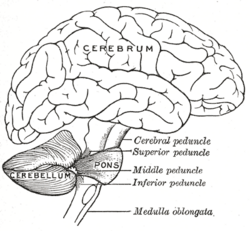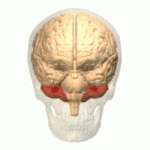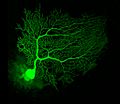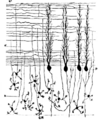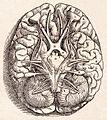Cerebellum facts for kids
| Brain: Cerebellum | ||
|---|---|---|
Quick facts for kids
|
||
| Drawing of the human brain, showing cerebellum and pons | ||
| Location of the human cerebellum (in red) | ||
| Latin | Cerebellum | |
| Part of | Hindbrain | |
| Artery | SCA, AICA, PICA | |
| Vein | superior, inferior | |
The cerebellum is a special part of your brain. Its name means "little brain" in Latin. It is found at the back of your head, tucked under the main part of your brain. This "little brain" is very important for how you move and keep your balance. It helps make your movements smooth and precise.
Contents
What is the Cerebellum?
The word cerebellum comes from the Latin word cerebrum, which means "brain". So, cerebellum literally means "little brain". It's a good name because it looks like a smaller version of the main brain.
How the Cerebellum Helps You Move
The cerebellum is super important for how you control your body. It helps with many things, like:
- Making your movements smooth and coordinated.
- Helping you keep your balance so you don't fall.
- Making sure your movements happen at the right time.
Think about riding a bike or playing a sport. Your cerebellum is working hard to make sure your arms and legs move together perfectly. It doesn't start the movement, but it makes sure the movement is just right.
The cerebellum gets information from your spinal cord and other parts of your brain. It uses this information to fine-tune your actions. This means it makes small adjustments to your movements as you do them.
When the Cerebellum is Damaged
If the cerebellum gets hurt, it can cause problems with movement. People might have trouble with:
- Fine movements: Like writing or picking up small objects.
- Balance: They might feel wobbly or have trouble standing straight.
- Posture: How they hold their body.
- Learning new movements: Like learning a dance or a new sport.
When the cerebellum is damaged, movements can become shaky or uncoordinated. It's like trying to draw a straight line but your hand keeps wiggling.
The Cerebellum's Structure
The human cerebellum is a separate structure located at the bottom of the brain. It sits underneath the large cerebral hemispheres.
The cerebellum has a tightly folded outer layer called the cortex. This layer is made of "grey matter." Underneath this grey matter is "white matter." Inside the white matter, there are four groups of nerve cells called deep cerebellar nuclei. These nuclei send signals out from the cerebellum to other parts of the brain.
If you could unfold the human cerebellar cortex, it would be about 1 meter long and 5 centimeters wide. That's a lot of brain tissue packed into a small space!
Interesting Facts About the Cerebellum
- Doctors in Ancient Greece knew about the cerebellum.
- A famous ancient doctor named Galen described it first. He thought it was where nerves for movement came from.
- The human cerebellum changes as people get older.
- In very old people (like those over 100), the cerebellum often looks "younger" than other parts of their brain. It can seem about 15 years younger than expected!
- Most animals with a backbone (like fish, birds, and mammals) have a cerebellum.
- Many things can cause damage to the cerebellum. These include a stroke, bleeding in the brain, brain swelling, tumors, too much alcohol, and physical trauma.
Images for kids
-
A cross-section of a porbeagle shark's brain, with the cerebellum in blue.
-
A drawing of the bottom of the human brain from 1543 by Andreas Vesalius.
See also
 In Spanish: Cerebelo para niños
In Spanish: Cerebelo para niños


